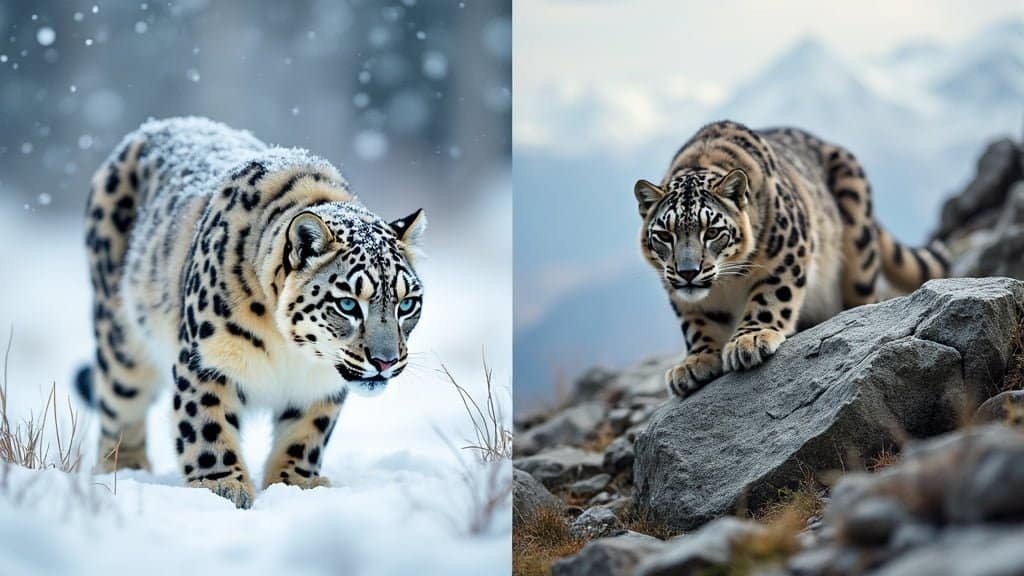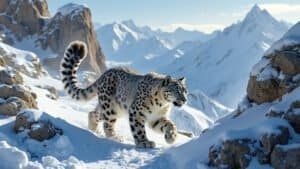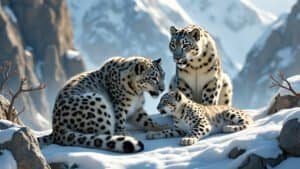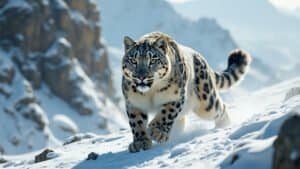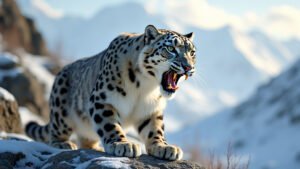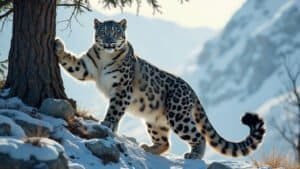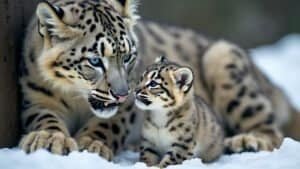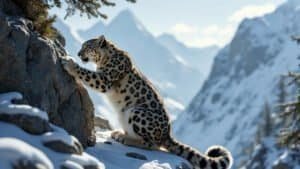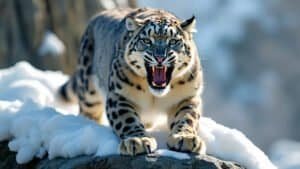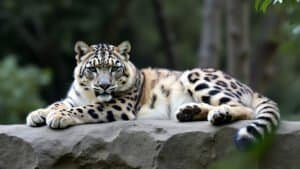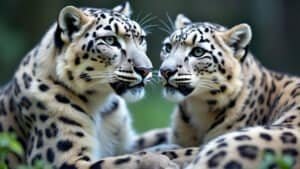Introduction
Snow leopards, known for their elusive nature and solitary behavior, inhabit the rugged mountainous regions of Central and South Asia. To survive in such harsh environments, these big cats must adapt their hunting strategies to the changing seasons
This article explores how snow leopards modify their hunting techniques between winter and summer, how their camouflage changes, and what adaptations help them tackle environmental challenges
From stalking prey in snow-covered landscapes to navigating rocky terrain, we delve into the fascinating ways these predators maintain their position at the top of the food chain
Winter Hunting Strategies of Snow Leopards
Snow leopards are master hunters adapted to some of the most extreme conditions on Earth. During the winter season, the harsh snow-covered terrain of the mountainous regions poses unique challenges and opportunities for these elusive predators
The snow leopards’ ability to navigate through deep snow and their incredible camouflage techniques are key to their hunting success in this period. Their hunting strategies in winter revolve around using the snow to their advantage, maximizing their physical adaptations, and targeting specific prey that is easier to catch in these conditions
Snow Leopards’ Behavior in Snowy Terrain
Snow leopards are built to thrive in snowy environments. Their large, fur-covered paws act like snowshoes, distributing their weight evenly and allowing them to walk on snow without sinking
This adaptation provides a significant advantage when stalking prey in deep snow. Their thick fur, which changes slightly in shade with the seasons, provides both warmth and camouflage, blending perfectly with the winter landscape of snow and rocks
During the winter months, snow leopards tend to descend to lower altitudes where prey such as ibex, bharal (blue sheep), and young yaks are more accessible. The snow’s depth at higher elevations often forces these herbivores to migrate to lower areas, where snow leopards follow
Their ability to leap up to 50 feet enables them to close distances rapidly in snowy and rugged terrain, a critical factor when ambushing prey
Camouflage Techniques for Winter Hunting
Camouflage plays a pivotal role in the snow leopard’s winter hunting strategy. Their thick, smoky-gray fur with dark rosettes and spots mimics the rocky, snow-dusted environment, allowing them to remain nearly invisible to prey. The natural pattern of their coat breaks up their outline, making them difficult to detect against the snowy backdrop
Snow leopards are known for their patience and stealth, often lying in wait for hours, hidden by their natural camouflage, to ambush unsuspecting prey
A study published in Biological Conservation in 2020 emphasized how crucial this camouflage is for snow leopards’ hunting efficiency, particularly in areas where prey is sparse due to harsh winter conditions. This ability to blend into the environment makes them one of the most effective ambush predators in the animal kingdom
Winter Prey and Stalking Methods
The choice of prey during winter is strategic. Snow leopards typically target medium to large herbivores that are weakened by the cold, lack of food, or deep snow
Their primary prey includes ibex, bharal, argali sheep, and marmots, depending on the region. Winter often forces these animals into more predictable patterns as they move along ridges and valleys, making it easier for snow leopards to anticipate their movements
Snow leopards employ a combination of stalking and ambush techniques during winter hunts. They use rocky outcrops and cliffs to their advantage, stalking their prey from above and using gravity to assist in a rapid descent during the attack
According to research from the Snow Leopard Trust, snow leopards often initiate hunts from a vantage point about 20-50 feet above their prey, leaping down and utilizing their powerful hind legs to pounce accurately
This strategy conserves energy while increasing the likelihood of a successful kill, essential in a cold environment where energy conservation is crucial for survival
Summer Hunting Strategies of Snow Leopards
As the seasons change and the snow melts away, snow leopards must adjust their hunting techniques to cope with the warmer and more rugged terrain of summer
In this season, the landscape transforms from a snowy expanse to a rocky, barren environment, significantly altering the conditions for hunting. Snow leopards must navigate through steep, rocky outcrops, grassy meadows, and mountain ridges, employing different strategies to successfully hunt their prey
Adapting to Warmer, Rocky Environments
During the summer months, the terrain becomes more varied, with patches of exposed rocks, sparse vegetation, and less snow cover
Snow leopards take advantage of these rocky environments to stalk and ambush prey. Their powerful build, flexible spine, and long tail aid in maintaining balance and agility as they navigate narrow ledges and rugged slopes
Unlike in winter, where deep snow can slow down both predator and prey, summer presents fewer physical barriers. Snow leopards must rely more on their stealth and agility, as the lack of snow makes it harder to hide their approach
They often use the rugged landscape to their advantage, creeping low among rocks and boulders to remain unseen. The sharp cliffs and rocky terrain provide ample cover for these stealthy hunters, who often choose higher ground to gain a better vantage point over their prey
Changes in Prey Availability and Hunting Tactics
The change in season brings about a shift in prey availability. In summer, snow leopards encounter a wider variety of prey, including smaller mammals such as hares, marmots, and birds, in addition to their usual larger herbivores like ibex and blue sheep
Marmots, in particular, become a significant food source. These rodents are easier to spot and hunt in the summer when they come out to forage and bask in the sun
Snow leopards employ a more opportunistic hunting strategy in summer due to this diverse prey availability. They may stalk smaller prey for a quick meal or strategically target larger animals when the opportunity arises. Unlike winter, where they may rely on fewer, high-calorie kills to sustain themselves, summer allows for more frequent but varied hunting
A study published in the Journal of Mammalogy in 2018 highlights how snow leopards adjust their hunting behavior based on prey type and density. The study found that in summer, snow leopards increase their hunting range and frequency, targeting smaller prey when larger ungulates are less concentrated
Physical and Behavioral Adaptations for Summer
To cope with the increased movement and the need to cover larger areas in search of prey during summer, snow leopards rely heavily on their endurance and flexibility
Their muscular bodies, particularly their powerful hind legs, provide the strength needed to leap between rocks and chase agile prey across rugged terrain. Snow leopards can leap up to 30 feet horizontally, an adaptation that proves advantageous in their rocky, mountainous habitat
Behaviorally, snow leopards also shift their activity patterns. While they are generally crepuscular (most active at dawn and dusk), during summer, they may adjust their hunting times to cooler parts of the day to avoid overheating and conserve energy
The increased daylight hours allow them more time to hunt and patrol their territory, but they must also be cautious of other predators and potential threats in their habitat
The seasonal shift in hunting strategy showcases the snow leopard’s remarkable ability to adapt to varying environmental conditions. From utilizing rocky outcrops to targeting different prey species, these big cats demonstrate a high level of flexibility and resourcefulness to thrive throughout the year
The Role of Camouflage in Snow Leopards’ Seasonal Hunting
Camouflage is a vital aspect of the snow leopard’s survival strategy, playing a crucial role in both winter and summer hunting
As solitary and stealthy hunters, snow leopards rely heavily on their ability to blend into their surroundings to avoid detection by prey and to successfully ambush them. The changing seasons bring different challenges and opportunities for using camouflage, which the snow leopard must skillfully navigate
Winter Camouflage Techniques
In winter, the snow leopard’s coat provides excellent camouflage against the snow-covered rocky slopes. Their thick, pale gray fur with dark rosettes mimics the snow-dusted terrain, allowing them to remain nearly invisible to both prey and potential threats
The dense, long fur also provides insulation against the cold, a necessary adaptation for surviving and hunting in sub-zero temperatures
The importance of this camouflage is underscored during winter hunts when prey animals like ibex and blue sheep are also more vigilant due to limited food sources and increased vulnerability in snowy landscapes
A 2019 study published in Mammalian Biology found that snow leopards have a significantly higher success rate in hunts where they can leverage their natural camouflage. This stealth allows them to get much closer to their prey before launching an attack, conserving energy—a critical factor in the harsh winter months when both predator and prey are more prone to fatigue and energy depletion
Blending into the Summer Terrain
As the snow melts and the landscape changes, snow leopards must adapt their camouflage to the new environment. During the summer, their coat blends with the rocky terrain and sparse vegetation of their mountainous habitat
The rosettes and spots break up the outline of their bodies against the mottled background of rocks, shadows, and grasses, making it challenging for prey to detect them from a distance
Unlike in winter, where snow leopards can often rely on white, snow-covered areas to conceal themselves, summer presents a more varied palette of colors and textures
This variety requires the snow leopard to be more strategic in choosing stalking routes and hiding spots. Studies have observed that snow leopards will often lie in ambush in shadowed areas, using their color pattern to blend with shadows cast by rocks or overhangs. This not only hides them from prey but also helps in regulating their body temperature by staying out of direct sunlight
How Camouflage Affects Hunting Success
The effectiveness of camouflage directly influences the hunting success of snow leopards. In both winter and summer, the ability to remain undetected until the final moments of an attack is paramount
A 2021 study in The Journal of Wildlife Management highlighted that camouflage effectiveness can increase a snow leopard’s kill rate by up to 60% compared to scenarios where their coat provides less blending
In addition, snow leopards tend to avoid areas where their camouflage might be compromised. For instance, they rarely hunt in open fields where they are easily spotted. Instead, they favor broken terrain with rocks, boulders, and cliffs that complement their coat patterns
This preference for complex terrains further emphasizes how integral camouflage is to their hunting strategy
Overall, the ability to blend into their environment allows snow leopards to maximize their energy efficiency while hunting, reducing the likelihood of failed hunts that could lead to energy loss and potential starvation. Whether in the snow-draped mountains of winter or the rocky slopes of summer, the snow leopard’s mastery of camouflage remains a cornerstone of its survival strategy
Challenges and Adaptations in Snow Leopards’ Hunting
Snow leopards face numerous challenges throughout the year as they hunt in the harsh and ever-changing environments of the mountains. Both the winter and summer seasons bring unique obstacles, from dealing with extreme weather conditions to changes in prey availability
To overcome these challenges, snow leopards have developed a range of physical and behavioral adaptations that allow them to hunt efficiently and maintain their role as apex predators
Dealing with Seasonal Changes in Prey Patterns
One of the main challenges for snow leopards is the seasonal fluctuation in prey availability. During the winter months, their primary prey, such as blue sheep, ibex, and Himalayan tahr, often descend to lower elevations in search of food
Snow leopards must follow these migrations, which can increase the competition for limited resources among predators. The prey animals, weakened by harsh conditions and lack of food, can also be more alert and difficult to hunt
In the summer, as prey animals disperse more widely across the mountains in search of fresh grasses and water sources, snow leopards must cover greater distances to locate and stalk them. This dispersal results in fewer concentrated hunting opportunities, requiring snow leopards to expand their territories and patrol larger areas
According to a study published in Ecology and Evolution in 2018, snow leopards can range over areas up to 80 square miles, depending on prey density and terrain, highlighting the vast distances they may travel to find food in different seasons
Energy Conservation Strategies During Hunts
Energy conservation is crucial for snow leopards, particularly during the winter months when food is scarce, and the energy costs of hunting in snow are high. To cope with these conditions, snow leopards have developed efficient hunting techniques that minimize energy expenditure
Their stalking and ambush tactics, where they remain motionless and hidden for long periods before launching a sudden attack, are key strategies to avoid unnecessary chases that can deplete valuable energy reserves
In extreme cold, snow leopards also adjust their metabolism to conserve energy. They may reduce their activity levels, limit their movements to essential hunting and patrolling, and increase rest periods to minimize caloric loss
This adaptation is essential for surviving long winters when successful hunts may be few and far between. Research from the Snow Leopard Trust indicates that snow leopards might go without food for up to two weeks in such scenarios, relying on their fat reserves and reduced energy expenditure to sustain them during lean periods
Overcoming Environmental Challenges in Different Seasons
Snow leopards must also contend with the rugged and often treacherous mountain terrain, which varies significantly between seasons. In winter, the deep snow can hamper movement, making both hunting and patrolling more challenging
However, their large paws and muscular limbs help them navigate snow-covered landscapes with relative ease compared to their prey, which may struggle in the deep snow
In summer, snow leopards must navigate steep, rocky terrain where loose gravel, cliffs, and sharp rocks present hazards. Their thick, muscular tails play a critical role in maintaining balance while moving across narrow ledges or leaping between rocks
This balance is crucial when chasing agile prey like mountain goats or blue sheep, which are also adapted to rocky terrains
Behaviorally, snow leopards are highly adaptable and can modify their hunting strategies based on environmental changes. For example, they may choose to hunt during cooler times of the day in summer to avoid heat exhaustion or alter their stalking routes to take advantage of the shadows cast by rocks and cliffs
These behavioral shifts, along with their physical adaptations, make snow leopards highly resilient predators capable of thriving in some of the world’s most extreme environments
Conclusion
Snow leopards exhibit remarkable adaptability in their hunting strategies, allowing them to thrive in the harsh, varied environments of their mountainous habitats. Whether facing the deep snow and cold temperatures of winter or navigating the rocky, warmer terrains of summer, these elusive predators have evolved a range of physical and behavioral adaptations that enable them to hunt effectively throughout the year
Their powerful build, stealthy camouflage, and strategic hunting techniques reflect their capacity to cope with fluctuating prey availability, extreme weather conditions, and challenging terrains. By understanding the complexities of snow leopards’ seasonal hunting strategies, we gain insight into the resilience and resourcefulness of one of nature’s most magnificent big cats
